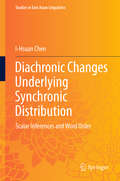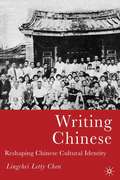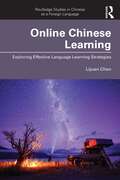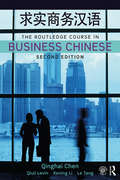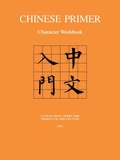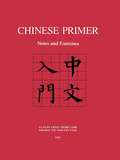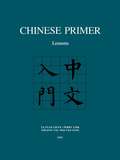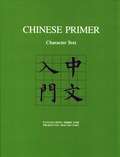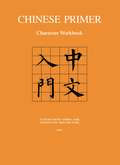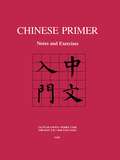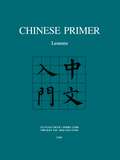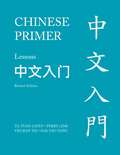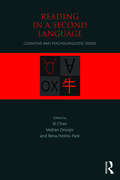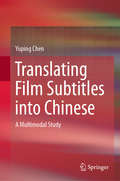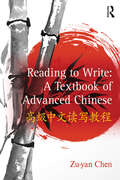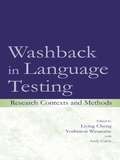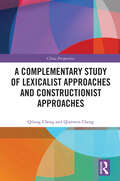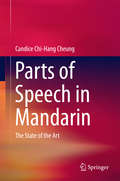- Table View
- List View
Diachronic Changes Underlying Synchronic Distribution: Scalar Inferences and Word Order (Studies in East Asian Linguistics)
by I-Hsuan ChenThis book deals with synchronic variation in Chinese through a diachronic lens, based on the evidence from a quantitative, longitudinal corpus study. Departing from the traditional analysis in diachronic changes in Chinese linguistics, the cognitive constructionist approach employed in this book is able to capture incremental changes by combining syntax, semantics, and pragmatics. Topics such as word order, focus, scopes of quantifiers, information structure, and negation have been important issues in linguistics, but they are rarely integrated as a whole. The book makes their diachronic interactions available to the students and researchers in the fields of general and Chinese linguistics.
Writing Chinese: Reshaping Chinese Cultural Identity
by L. ChenThis is a comparative study of the politics of Chinese cultural identity facing China, Taiwan, Hong Kong, the US-Chinese, and the Chinese diaspora in the West. The author challenges current discussions of hybridity and nationalism by contrasting the experiences of Taiwan, Hong Kong and US-Chinese with those of China and the Chinese diaspora.
Online Chinese Learning: Exploring Effective Language Learning Strategies (Routledge Studies in Chinese as a Foreign Language)
by Lijuan ChenOnline Chinese Learning aims to investigate the types of language learning strategies (LLSs) that online Chinese learners use across asynchronous and synchronous learning environments in different learning contexts.This book examines how the use of language learning strategies by online Chinese learners is influenced by the interactants; the characteristics of the specific learning context; and selected individual learner characteristics. This book will provide: (1) new and detailed information about students’ LLS use in online Chinese learning; (2) insights into how individual students adopt LLSs and technological tools to solve learning problems in various learning contexts; (3) an exploration of factors influencing LLS use; and (4) recommendations regarding LLS adoption, use, and training.This book will be a valuable resource for university instructors in languages, language teaching methods, and second language acquisition, as well as researchers in languages, linguistics, and language learning and teaching.
Online Chinese Learning: Exploring Effective Language Learning Strategies (Routledge Studies in Chinese as a Foreign Language)
by Lijuan ChenOnline Chinese Learning aims to investigate the types of language learning strategies (LLSs) that online Chinese learners use across asynchronous and synchronous learning environments in different learning contexts.This book examines how the use of language learning strategies by online Chinese learners is influenced by the interactants; the characteristics of the specific learning context; and selected individual learner characteristics. This book will provide: (1) new and detailed information about students’ LLS use in online Chinese learning; (2) insights into how individual students adopt LLSs and technological tools to solve learning problems in various learning contexts; (3) an exploration of factors influencing LLS use; and (4) recommendations regarding LLS adoption, use, and training.This book will be a valuable resource for university instructors in languages, language teaching methods, and second language acquisition, as well as researchers in languages, linguistics, and language learning and teaching.
The Routledge Course in Business Chinese
by Qinghai Chen Qiuli Levin Kening Li Le Tang• Fourth-year language learning or above in preparation for real-life business situations各专业学生汉语四年级(或以上)适用 • Timeless business topics ranging from frequently occurring business activities, economic systems and phenomena, to issues of broad interest使用通用商务题材确保教材长期相对稳定 • Simulated real-world tasks connecting the classroom to China’s current economic developments through students’ own efforts组织大量以学生为主体的任务型实践活动 ,实现题材即时更新 • A focus on formal language style and business terminology 注重正式语体和专业词语的学习 • Summary of important features of Chinese with emphasis on language learning skills to cultivate self-sustained and effective language learners 归纳汉语基本特点,教授学习方法,培养自学能力
The Routledge Course in Business Chinese
by Qinghai Chen Qiuli Levin Kening Li Le Tang• Fourth-year language learning or above in preparation for real-life business situations各专业学生汉语四年级(或以上)适用 • Timeless business topics ranging from frequently occurring business activities, economic systems and phenomena, to issues of broad interest使用通用商务题材确保教材长期相对稳定 • Simulated real-world tasks connecting the classroom to China’s current economic developments through students’ own efforts组织大量以学生为主体的任务型实践活动 ,实现题材即时更新 • A focus on formal language style and business terminology 注重正式语体和专业词语的学习 • Summary of important features of Chinese with emphasis on language learning skills to cultivate self-sustained and effective language learners 归纳汉语基本特点,教授学习方法,培养自学能力
Chinese Primer: Character Workbook (GR) (PDF)
by Ta-Tuan Ch'En Perry Link Yih-Jian Tai Hai-Tao TangFour experienced teachers of beginning Chinese have developed this introductory textbook. A pilot edition has been tested widely in classrooms and refined over a period of years. Among its salient features are lessons that are lively, amusing, and relevant to everyday life: concentrated training of ear and tongue in the sound system of Chinese; extensive grammar notes, clearly presented, with attention to mistakes English-speakers are likely to make; a carefully sequenced character workbook embodying a new and effective approach to the learning of Chinese characters; and audiovisual reinforcement via a complete set of audiotapes and two videotapes, one of which offers entertaining dramatizations of the lesson dialogues. The Chinese Primer is available in two versions, one using the GR system of romanization, which employs different spellings instead of diacritical marks for different tones, the other using Pinyin romanization. The contents of the four volumes are as follows: (1) Blue Book [Lessons]: Introduction; foundation work on pronunciation; lesson dialogues in romanized Chinese and English; appendices; glossary-index. (2) Red Book [Notes and Exercises]: Vocabularies; grammar notes and culture notes keyed to the lessons; exercises. (3) Yellow Book [ Character Workbook ]: workbook. (4) Green Book [Pinyin Character Text]: Texts of the lessons in both traditional and simplified Chinese characters, and a Chinese introduction for teachers. The first three volumes: Blue Book, Red Book, and Yellow Book are sold as a set (GR Set or Pinyin Set). In addition, the GR Blue Book [Lessons], GR Red Book [Notes and Exercises], and GR Yellow Book [ Character Workbook ], along with the Pinyin Green Book [Pinyin Character Text] are sold separately. The GR Audio and video materials are available from the Chinese Linguistics Project at Princeton University for use with this text. These supplementary materials are not published by Princeton University Press. For further information and prices, contact the Chinese Linguistics Project, 231 Palmer Hall, Princeton University, Princeton, N.J. 08544. (609-258-4269).
Chinese Primer: Notes and Exercises (GR) (PDF)
by Ta-Tuan Ch'En Perry Link Yih-Jian Tai Hai-Tao TangFour experienced teachers of beginning Chinese have developed this introductory textbook. A pilot edition has been tested widely in classrooms and refined over a period of years. Among its salient features are lessons that are lively, amusing, and relevant to everyday life: concentrated training of ear and tongue in the sound system of Chinese; extensive grammar notes, clearly presented, with attention to mistakes English-speakers are likely to make; a carefully sequenced character workbook embodying a new and effective approach to the learning of Chinese characters; and audiovisual reinforcement via a complete set of audiotapes and two videotapes, one of which offers entertaining dramatizations of the lesson dialogues. The Chinese Primer is available in two versions, one using the GR system of romanization, which employs different spellings instead of diacritical marks for different tones, the other using Pinyin romanization. The contents of the four volumes are as follows: (1) Blue Book [Lessons]: Introduction; foundation work on pronunciation; lesson dialogues in romanized Chinese and English; appendices; glossary-index. (2) Red Book [ Notes and Exercises ]: Vocabularies; grammar notes and culture notes keyed to the lessons; exercises. (3) Yellow Book [Character Workbook]: workbook. (4) Green Book [Pinyin Character Text]: Texts of the lessons in both traditional and simplified Chinese characters, and a Chinese introduction for teachers. The first three volumes: Blue Book, Red Book, and Yellow Book are sold as a set (GR Set or Pinyin Set). In addition, the GR Blue Book [Lessons], GR Red Book [ Notes and Exercises ], and GR Yellow Book [Character Workbook] , along with the Pinyin Green Book [Pinyin Character Text], along with the Pinyin Green Book [Pinyin Character Text] are sold separately. The GR Audio and video materials are available from the Chinese Linguistics Project at Princeton University for use with this text. These supplementary materials are not published by Princeton University Press. For further information and prices, contact the Chinese Linguistics Project, 231 Palmer Hall, Princeton University, Princeton, N.J. 08544. (609-258-4269).
Chinese Primer: Lessons (GR) (PDF)
by Ta-Tuan Ch'En Perry Link Yih-Jian Tai Hai-Tao TangFour experienced teachers of beginning Chinese have developed this introductory textbook. A pilot edition has been tested widely in classrooms and refined over a period of years. Among its salient features are lessons that are lively, amusing, and relevant to everyday life: concentrated training of ear and tongue in the sound system of Chinese; extensive grammar notes, clearly presented, with attention to mistakes English-speakers are likely to make; a carefully sequenced character workbook embodying a new and effective approach to the learning of Chinese characters; and audiovisual reinforcement via a complete set of audiotapes and two videotapes, one of which offers entertaining dramatizations of the lesson dialogues. The Chinese Primer is available in two versions, one using the GR system of romanization, which employs different spellings instead of diacritical marks for different tones, the other using Pinyin romanization. The contents of the four volumes are as follows: (1) Blue Book [ Lessons ]: Introduction; foundation work on pronunciation; lesson dialogues in romanized Chinese and English; appendices; glossary-index. (2) Red Book [Notes and Exercises]: Vocabularies; grammar notes and culture notes keyed to the lessons; exercises. (3) Yellow Book [Character Workbook]: workbook. (4) Green Book [Pinyin Character Text]: Texts of the lessons in both traditional and simplified Chinese characters, and a Chinese introduction for teachers. The first three volumes: Blue Book, Red Book, and Yellow Book are sold as a set (GR Set or Pinyin Set). In addition, the GR Blue Book [ Lessons ], GR Red Book [Notes and Exercises], and GR Yellow Book [Character Workbook], along with the Pinyin Green Book [Pinyin Character Text] are sold separately. The GR Audio and video materials are available from the Chinese Linguistics Project at Princeton University for use with this text. These supplementary materials are not published by Princeton University Press. For further information and prices, contact the Chinese Linguistics Project, 231 Palmer Hall, Princeton University, Princeton, N.J. 08544. (609-258-4269).
Chinese Primer: Character Text (Pinyin) (The Princeton Language Program: Modern Chinese #45)
by Ta-tuan Ch'en Perry Link Yih-jian Tai Hai-tao TangFour experienced teachers of beginning Chinese have developed this introductory textbook. A pilot edition has been tested widely in classrooms and refined over a period of years. Among its salient features are lessons that are lively, amusing, and relevant to everyday life: concentrated training of ear and tongue in the sound system of Chinese; extensive grammar notes, clearly presented, with attention to mistakes English-speakers are likely to make; a carefully sequenced character workbook embodying a new and effective approach to the learning of Chinese characters; and audiovisual reinforcement via a complete set of audiotapes and two videotapes, one of which offers entertaining dramatizations of the lesson dialogues. The Chinese Primer is available in two versions, one using the GR system of romanization, which employs different spellings instead of diacritical marks for different tones, the other using Pinyin romanization. The contents of the four volumes are as follows: (1) Blue Book [Lessons]: Introduction; foundation work on pronunciation; lesson dialogues in romanized Chinese and English; appendices; glossary-index. (2) Red Book [Notes and Exercises]: Vocabularies; grammar notes and culture notes keyed to the lessons; exercises. (3) Yellow Book [Character Workbook]: workbook. (4) Green Book [ Pinyin Character Text ]: Texts of the lessons in both traditional and simplified Chinese characters, and a Chinese introduction for teachers. The first three volumes: Blue Book, Red Book, and Yellow Book are sold as a set (GR Set or Pinyin Set). In addition, the GR Blue Book [Lessons], GR Red Book [Notes and Exercises], and GR Yellow Book [Character Workbook], along with the Pinyin Green Book [ Pinyin Character Text ] are sold separately. The GR Audio and video materials are available from the Chinese Linguistics Project at Princeton University for use with this text. These supplementary materials are not published by Princeton University Press. For further information and prices, contact the Chinese Linguistics Project, 231 Palmer Hall, Princeton University, Princeton, N.J. 08544. (609-258-4269).
Chinese Primer: Character Workbook (GR)
by Ta-tuan Ch'en Perry Link Yih-jian Tai Hai-tao TangFour experienced teachers of beginning Chinese have developed this introductory textbook. A pilot edition has been tested widely in classrooms and refined over a period of years. Among its salient features are lessons that are lively, amusing, and relevant to everyday life: concentrated training of ear and tongue in the sound system of Chinese; extensive grammar notes, clearly presented, with attention to mistakes English-speakers are likely to make; a carefully sequenced character workbook embodying a new and effective approach to the learning of Chinese characters; and audiovisual reinforcement via a complete set of audiotapes and two videotapes, one of which offers entertaining dramatizations of the lesson dialogues. The Chinese Primer is available in two versions, one using the GR system of romanization, which employs different spellings instead of diacritical marks for different tones, the other using Pinyin romanization. The contents of the four volumes are as follows: (1) Blue Book [Lessons]: Introduction; foundation work on pronunciation; lesson dialogues in romanized Chinese and English; appendices; glossary-index. (2) Red Book [Notes and Exercises]: Vocabularies; grammar notes and culture notes keyed to the lessons; exercises. (3) Yellow Book [ Character Workbook ]: workbook. (4) Green Book [Pinyin Character Text]: Texts of the lessons in both traditional and simplified Chinese characters, and a Chinese introduction for teachers. The first three volumes: Blue Book, Red Book, and Yellow Book are sold as a set (GR Set or Pinyin Set). In addition, the GR Blue Book [Lessons], GR Red Book [Notes and Exercises], and GR Yellow Book [ Character Workbook ], along with the Pinyin Green Book [Pinyin Character Text] are sold separately. The GR Audio and video materials are available from the Chinese Linguistics Project at Princeton University for use with this text. These supplementary materials are not published by Princeton University Press. For further information and prices, contact the Chinese Linguistics Project, 231 Palmer Hall, Princeton University, Princeton, N.J. 08544. (609-258-4269).
Chinese Primer: Notes and Exercises (GR)
by Ta-tuan Ch'en Perry Link Yih-jian Tai Hai-tao TangFour experienced teachers of beginning Chinese have developed this introductory textbook. A pilot edition has been tested widely in classrooms and refined over a period of years. Among its salient features are lessons that are lively, amusing, and relevant to everyday life: concentrated training of ear and tongue in the sound system of Chinese; extensive grammar notes, clearly presented, with attention to mistakes English-speakers are likely to make; a carefully sequenced character workbook embodying a new and effective approach to the learning of Chinese characters; and audiovisual reinforcement via a complete set of audiotapes and two videotapes, one of which offers entertaining dramatizations of the lesson dialogues. The Chinese Primer is available in two versions, one using the GR system of romanization, which employs different spellings instead of diacritical marks for different tones, the other using Pinyin romanization. The contents of the four volumes are as follows: (1) Blue Book [Lessons]: Introduction; foundation work on pronunciation; lesson dialogues in romanized Chinese and English; appendices; glossary-index. (2) Red Book [ Notes and Exercises ]: Vocabularies; grammar notes and culture notes keyed to the lessons; exercises. (3) Yellow Book [Character Workbook]: workbook. (4) Green Book [Pinyin Character Text]: Texts of the lessons in both traditional and simplified Chinese characters, and a Chinese introduction for teachers. The first three volumes: Blue Book, Red Book, and Yellow Book are sold as a set (GR Set or Pinyin Set). In addition, the GR Blue Book [Lessons], GR Red Book [ Notes and Exercises ], and GR Yellow Book [Character Workbook] , along with the Pinyin Green Book [Pinyin Character Text], along with the Pinyin Green Book [Pinyin Character Text] are sold separately. The GR Audio and video materials are available from the Chinese Linguistics Project at Princeton University for use with this text. These supplementary materials are not published by Princeton University Press. For further information and prices, contact the Chinese Linguistics Project, 231 Palmer Hall, Princeton University, Princeton, N.J. 08544. (609-258-4269).
Chinese Primer: Lessons (GR)
by Ta-tuan Ch'en Perry Link Yih-jian Tai Hai-tao TangFour experienced teachers of beginning Chinese have developed this introductory textbook. A pilot edition has been tested widely in classrooms and refined over a period of years. Among its salient features are lessons that are lively, amusing, and relevant to everyday life: concentrated training of ear and tongue in the sound system of Chinese; extensive grammar notes, clearly presented, with attention to mistakes English-speakers are likely to make; a carefully sequenced character workbook embodying a new and effective approach to the learning of Chinese characters; and audiovisual reinforcement via a complete set of audiotapes and two videotapes, one of which offers entertaining dramatizations of the lesson dialogues. The Chinese Primer is available in two versions, one using the GR system of romanization, which employs different spellings instead of diacritical marks for different tones, the other using Pinyin romanization. The contents of the four volumes are as follows: (1) Blue Book [ Lessons ]: Introduction; foundation work on pronunciation; lesson dialogues in romanized Chinese and English; appendices; glossary-index. (2) Red Book [Notes and Exercises]: Vocabularies; grammar notes and culture notes keyed to the lessons; exercises. (3) Yellow Book [Character Workbook]: workbook. (4) Green Book [Pinyin Character Text]: Texts of the lessons in both traditional and simplified Chinese characters, and a Chinese introduction for teachers. The first three volumes: Blue Book, Red Book, and Yellow Book are sold as a set (GR Set or Pinyin Set). In addition, the GR Blue Book [ Lessons ], GR Red Book [Notes and Exercises], and GR Yellow Book [Character Workbook], along with the Pinyin Green Book [Pinyin Character Text] are sold separately. The GR Audio and video materials are available from the Chinese Linguistics Project at Princeton University for use with this text. These supplementary materials are not published by Princeton University Press. For further information and prices, contact the Chinese Linguistics Project, 231 Palmer Hall, Princeton University, Princeton, N.J. 08544. (609-258-4269).
Chinese Primer, Volumes 1-3 (The Princeton Language Program: Modern Chinese #4)
by Ta-tuan Ch'en Perry Link Yih-jian Tai Hai-tao TangFour experienced teachers of beginning Chinese have developed this introductory textbook. A pilot edition has been tested widely in classrooms and refined over a period of years. Among its salient features are lessons that are lively, amusing, and relevant to everyday life: concentrated training of ear and tongue in the sound system of Chinese; extensive grammar notes, clearly presented, with attention to mistakes English-speakers are likely to make; a carefully sequenced character workbook embodying a new and effective approach to the learning of Chinese characters; and audiovisual reinforcement via a complete set of audiotapes and two videotapes, one of which offers entertaining dramatizations of the lesson dialogues. The Chinese Primer is available in two versions, one using the GR system of romanization, which employs different spellings instead of diacritical marks for different tones, the other using Pinyin romanization. The contents of the four volumes are as follows: (1) Blue Book [Lessons]: Introduction; foundation work on pronunciation; lesson dialogues in romanized Chinese and English; appendices; glossary-index. (2) Red Book [Notes and Exercises]: Vocabularies; grammar notes and culture notes keyed to the lessons; exercises. (3) Yellow Book [Character Workbook]: workbook. (4) Green Book [Pinyin Character Text]: Texts of the lessons in both traditional and simplified Chinese characters, and a Chinese introduction for teachers. The first three volumes: Blue Book, Red Book, and Yellow Book are sold as a set GR Set or Pinyin Set). In addition, the GR Blue Book [Lessons], GR Red Book [Notes and Exercises], and GR Yellow Book [Character Workbook], along with the Pinyin Green Book [Pinyin Character Text] are sold separately. The GR Audio and video materials are available from the Chinese Linguistics Project at Princeton University for use with this text. These supplementary materials are not published by Princeton University Press. For further information and prices, contact the Chinese Linguistics Project, 231 Palmer Hall, Princeton University, Princeton, N.J. 08544. (609-258-4269).
Chinese Primer, Volumes 1-3: Revised Edition (The Princeton Language Program: Modern Chinese #44)
by Ta-tuan Ch'en Perry Link Yih-jian Tai Hai-tao TangThis revised and updated edition of the Chinese Primer--an introductory textbook in wide use for more than a decade--uses proven techniques to put beginning learners of Mandarin Chinese on the path toward true mastery. The goal of the book is internalization--to lead students to adopt Chinese as one of their own languages and not to regard it merely as an object of study and translation. Features include: Use of hànyu pinyin romanization Rigorous foundation work in pronunciation, including tones and the other special phonemes that are crucial to mastery Lesson texts that combine authentic, natural Chinese expression with lively everyday topics that allow students to immediately begin using Chinese themselves Carefully designed incremental introduction of grammar, accompanied by thorough and precise notes Completely revised notes that link Chinese language to Chinese culture-such as names, modes of address, and conventions of politeness Additional lessons for self-study during the summer following a first-year course A completely revised character workbook that introduces both traditional and simplified characters and that simulates the way native speakers learn characters as children: in small doses that eventually "catch up" with speaking ability Like its earlier edition, The Chinese Primer: Revised Edition is composed of three integrated volumes: (1) the Blue Book [Lessons]: introduction; foundation work on pronunciation; lesson dialogues in romanized Chinese and English; appendices; glossary-index; (2) the Red Book [Notes and Exercises]: vocabularies; grammar notes and culture notes keyed to the lessons; exercises; and (3) the Yellow Book [Character Workbook]. (There is also a fourth volume, the Green Book [Pinyin Character Text], which is sold separately.) Texts of the lessons are in both traditional and simplified Chinese characters, and there is a Chinese introduction for teachers.
Reading in a Second Language: Cognitive and Psycholinguistic Issues
by Xi Chen Rena Helms-Park Vedran DronjicReading in a Second Language offers a comprehensive survey of the phenomenon and process of reading in a second language, with graduate and upper-level undergraduate students in second language acquisition, psycholinguistics, and applied psychology as its primary audience. The book explores reading processes from a number of complementary standpoints, integrating perspectives from fields such as first and second language reading, second language acquisition, linguistics, psycholinguistics, and cognitive neuroscience. The first half examines major factors in second language reading: types of scripts, the cognitive and neural substrates of reading; metalinguistic awareness, word recognition, language transfer, and lexical knowledge. The second part of the book discusses the social and educational contexts in which reading development occurs, including issues related to pedagogy, the use of technology in the classroom, reading disorders, and policy making. Reading in a Second Language provides students with a full, logically organized overview of the primary factors that shape reading development and processes in a second language.
Reading in a Second Language: Cognitive and Psycholinguistic Issues
by Xi Chen Rena Helms-Park Vedran DronjicReading in a Second Language offers a comprehensive survey of the phenomenon and process of reading in a second language, with graduate and upper-level undergraduate students in second language acquisition, psycholinguistics, and applied psychology as its primary audience. The book explores reading processes from a number of complementary standpoints, integrating perspectives from fields such as first and second language reading, second language acquisition, linguistics, psycholinguistics, and cognitive neuroscience. The first half examines major factors in second language reading: types of scripts, the cognitive and neural substrates of reading; metalinguistic awareness, word recognition, language transfer, and lexical knowledge. The second part of the book discusses the social and educational contexts in which reading development occurs, including issues related to pedagogy, the use of technology in the classroom, reading disorders, and policy making. Reading in a Second Language provides students with a full, logically organized overview of the primary factors that shape reading development and processes in a second language.
Translating Film Subtitles into Chinese: A Multimodal Study
by Yuping ChenThis book examines three metafunction meanings in subtitle translation with three research foci, i.e., the main types of cross-modal interrelation, the primary function of semiotic interplay, and the key linguistic components influencing the subtitles. It goes beyond traditional textual analysis in translation studies; approaches subtitle translation from a multimodality standpoint; and breaks through the linguistic restraints on subtitling research by underscoring the role of semiotic interplay. In the field of multimodality, this book bridges subtitling and multimodality by investigating the interweaving relationships between different semiotic modes, and their corresponding impacts on subtitle translation.
Reading to Write: A Textbook of Advanced Chinese
by Zu-Yan ChenTraditionally, reading and writing are believed to be separate but related language processes and teachers follow the conventional wisdom of teaching in-depth reading, with writing as a tag-on issue. Therefore, there exists an increasingly urgent call for a well-rounded reading-writing curriculum and a theoretically-informed, empirically-based, student-centered advanced textbook that aims to develop the synergy between reading and writing. Reading to Write: A Textbook of Advanced Chinese is intended to fill this significant gap. It treats reading and writing as integrative parts and interactive skills in Chinese language teaching, putting them hand-in-hand, supplementing each other.
Reading to Write: A Textbook Of Advanced Chinese
by Zu-yan ChenTraditionally, reading and writing are believed to be separate but related language processes and teachers follow the conventional wisdom of teaching in-depth reading, with writing as a tag-on issue. Therefore, there exists an increasingly urgent call for a well-rounded reading-writing curriculum and a theoretically-informed, empirically-based, student-centered advanced textbook that aims to develop the synergy between reading and writing. Reading to Write: A Textbook of Advanced Chinese is intended to fill this significant gap. It treats reading and writing as integrative parts and interactive skills in Chinese language teaching, putting them hand-in-hand, supplementing each other.
Washback in Language Testing: Research Contexts and Methods
by Liying Cheng Yoshinori Watanabe Andy CurtisWashback refers to the influence of language testing on teaching and learning. This volume, at the important intersection of language testing and teaching practices, presents theoretical, methodological, and practical guidance for current and future washback studies. In the field of language testing, researchers' major interest has traditionally been focused on issues and solving problems inherent in tests in order to increase their reliability and validity. However, the washback effect goes well beyond the test itself to include factors, such as curriculum, teacher and learner behaviors inside and outside the classroom, their perceptions of the test, and how test scores are used. Only recently have researchers started to empirically investigate the phenomenon of washback. This volume of such research serves two essential purposes by:*providing an overview of the complexity of washback and the various contextual factors entangled within testing, teaching, and learning; and *presenting empirical studies from around the world that offer insights into the effects of washback in specific educational contexts and models of research on which future studies can be based. The extensive use of test scores for various educational and social purposes in society nowadays makes the washback effect a high-interest phenomenon in the day-to-day educational activities of teachers, researchers, program coordinators/directors, policymakers, and others in the field of education. Washback in Language Testing: Research Contexts and Methods is a valuable resource for those who are interested in the application of findings to actual teaching and learning situations or conduct washback research in their own contexts, including educational and psychological testing experts, as well as alternative assessment people in all fields, and for policy- and decision-makers in educational and testing organizations.
Washback in Language Testing: Research Contexts and Methods
by Liying Cheng Yoshinori Watanabe With Andy CurtisWashback refers to the influence of language testing on teaching and learning. This volume, at the important intersection of language testing and teaching practices, presents theoretical, methodological, and practical guidance for current and future washback studies. In the field of language testing, researchers' major interest has traditionally been focused on issues and solving problems inherent in tests in order to increase their reliability and validity. However, the washback effect goes well beyond the test itself to include factors, such as curriculum, teacher and learner behaviors inside and outside the classroom, their perceptions of the test, and how test scores are used. Only recently have researchers started to empirically investigate the phenomenon of washback. This volume of such research serves two essential purposes by:*providing an overview of the complexity of washback and the various contextual factors entangled within testing, teaching, and learning; and *presenting empirical studies from around the world that offer insights into the effects of washback in specific educational contexts and models of research on which future studies can be based. The extensive use of test scores for various educational and social purposes in society nowadays makes the washback effect a high-interest phenomenon in the day-to-day educational activities of teachers, researchers, program coordinators/directors, policymakers, and others in the field of education. Washback in Language Testing: Research Contexts and Methods is a valuable resource for those who are interested in the application of findings to actual teaching and learning situations or conduct washback research in their own contexts, including educational and psychological testing experts, as well as alternative assessment people in all fields, and for policy- and decision-makers in educational and testing organizations.
A Complementary Study of Lexicalist Approaches and Constructionist Approaches (China Perspectives)
by Qilong Cheng Qianwen ChengThis book presents a complementary study of lexicalist approaches and constructionist approaches in linguistics. Specifi c topics discussed include different versions of semantic roles, predicate decomposition, event structures, argument realizations, and cognitive construction grammars. For decades, the relationship between certain concepts and constructions along with related issues of verb-construction associations have been perennially taxing for both lexicalist and constructionist approaches alike. Indeed, in Chinese, unmatched verb-construction associations and the much richer alternate realizations pose very diffi cult problems. Based on a comparative study, the authors make an attempt to account for the possible correspondence between the delicacy of argument setting and the principles of their realization. They also account for the integration of construction with verbs in terms of their coherent conceptual content. The resultant newly developed model throws new light on these thorny Chinese problems. The book will appeal to scholars and students studying cognitive linguistics, cognitive semantics, computational linguistics, and also natural language processing. The book also brings up some new analysis of Chinese data for both researchers and learners of Modern Chinese.
A Complementary Study of Lexicalist Approaches and Constructionist Approaches (China Perspectives)
by Qilong Cheng Qianwen ChengThis book presents a complementary study of lexicalist approaches and constructionist approaches in linguistics. Specifi c topics discussed include different versions of semantic roles, predicate decomposition, event structures, argument realizations, and cognitive construction grammars. For decades, the relationship between certain concepts and constructions along with related issues of verb-construction associations have been perennially taxing for both lexicalist and constructionist approaches alike. Indeed, in Chinese, unmatched verb-construction associations and the much richer alternate realizations pose very diffi cult problems. Based on a comparative study, the authors make an attempt to account for the possible correspondence between the delicacy of argument setting and the principles of their realization. They also account for the integration of construction with verbs in terms of their coherent conceptual content. The resultant newly developed model throws new light on these thorny Chinese problems. The book will appeal to scholars and students studying cognitive linguistics, cognitive semantics, computational linguistics, and also natural language processing. The book also brings up some new analysis of Chinese data for both researchers and learners of Modern Chinese.
Parts of Speech in Mandarin: The State of the Art (Springerbriefs In Linguistics Ser. #0)
by Candice Chi-Hang CheungThis book offers a comprehensive survey of the major parts of speech in Mandarin. Seeking to identify the sets of universal and language-specific categories, it compares the range of categories available in Mandarin and the Indo-European languages and establishes six universal categories – nouns, verbs, adjectives, adverbs, prepositions and conjunctions – and three language-specific ones, namely classifiers, localizers and sentence-final particles. Incorporating insights from recent research findings and the diachronic development of the language, the book sheds new light on the factors that contribute to the long-standing debate on the categorical status of adjectives, prepositions and localizers in the extant literature. Bringing together the earlier general descriptions and the latest advances, it is broadly accessible to non-native and native speakers of the language and offers an ideal reference source for all students and scholars who are interested in studying the parts of speech in Mandarin.
